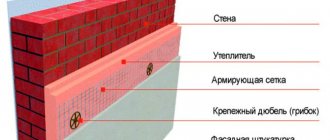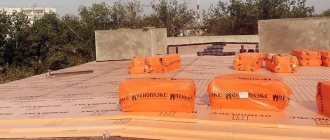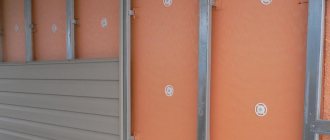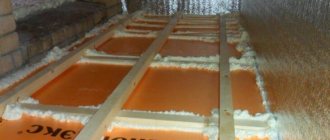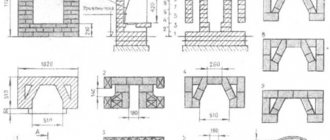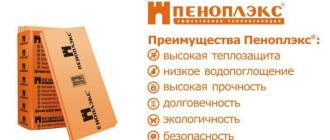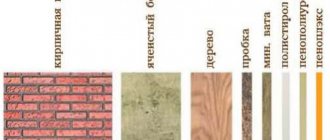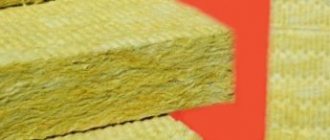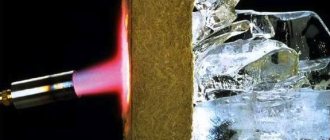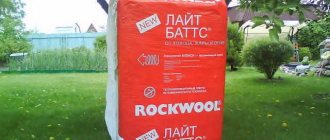began the history of Russian extruded polystyrene foam by launching in 1998 a production line for PENOPLEX boards at a plant in Kirishi, Leningrad Region.
Penoplex production method: Polystyrene granules enter an extruder, where they are heated and mixed under high pressure. At the same time, a gaseous blowing agent is supplied to the extruder. Thanks to high pressure and heat, the blowing agent enters the granules and increases their volume. The resulting mass is pressed through a die, the material is cooled and cut into slabs. As a result, small closed cells are formed in XPS, which give penoplex excellent thermal insulation properties and negligible water absorption.
Penoplex brands
- Penoplex COMFORT
- Penoplex BASE
- Penoplex FOUNDATION
- Penoplex GEO
- Penoplex ROOFING
- Penoplex FACADE
- Penoplex 45
What is this. History of the creation of the material
The material first appeared back in 1941, when the DOW CHEMICAL company (USA) patented a fundamentally new product with high thermal insulation properties and moisture resistance. The production of the material was put on stream, but initially it was manufactured only for the needs of the Navy.
Due to its resistance to wet environments, Penoplex has been used for the production of life rafts. After some time, the material began to be used in refrigeration units. Penoplex occupied its rightful niche only in 1950, when it began to be used in construction. It is curious that in the US construction market the material is known under the brand name STROYFOAM.
Penoplex is a Russian brand that appeared only in 1988.
What is Penoplex? Essentially, it is foamed polystyrene, which is produced on extrusion machines. In its structure, the material resembles polystyrene foam, which is familiar to many, but has a denser structure and, accordingly, better characteristics.
Analogue of thermal insulation material
We insulate the floor in the room using penoplex
Since the construction market is constantly updated with new materials that can be used in insulation processes, I decided to touch upon the topic of an analogue of penoplex with improved characteristics. This is the technoplex material, which is made from polystyrene foam, but thanks to the addition of nanoparticles of graphite, it has even lower thermal conductivity and improved density and strength.
By the way, the temperature regime of the technoplex is also expanded, and if penoplex can be used from -50 degrees, then technoplex from -75 to +75 degrees. However, if we talk about our climate, then such an indicator will not play any role and therefore I, like many, do not understand the need to use this variety. If we talk about the cost of the material, then technoplex is not much more expensive than penoplex. The difference is approximately 10%, although on large areas these percentages can cost a pretty penny.
The most interesting thing is that polystyrene foam has long been used not only as a good thermal insulation material. With its help, foam decor is created, which can turn the appearance of facades into a real work of art. Thanks to its low cost, anyone can afford to transform the appearance of a house, but the main thing is that this architectural element fits into the overall style of the building.
What is Penoplex made of? Compound
We have before us a completely artificial material, which is made from chemical components mixed in certain proportions. The technology involves using a temperature of 140 degrees, which causes the ingredients to melt and foam, forming porophores. If we talk about specifics, the following materials are used in production:
- Polystyrene.
- Ground perlite.
- Lemon acid.
- Tetrabromoparaxylene.
- Barium or zinc stearate.
- Bicarbonate of soda.
The use of such components in certain proportions forms a strong cellular-porous structure filled with gas.
Production technology and scope
The specifics of penoplex manufacturing are aimed at improving the strength and technical characteristics of the material.
It is given special properties by the process of extrusion from raw materials in special furnaces. First, polystyrene granules are mixed with a foaming agent under conditions of high humidity and temperature. The catalyst is a composition of carbon dioxide (CO2) and freon. The polystyrene foam composition is melted in ovens and resembles lush cream. Then, through the extrusion installation, the substance begins to be squeezed out, the freon gradually evaporates, and the cells are filled with simple air.
Currently, heat insulation is in demand in different climatic conditions for insulation and protection:
- foundations and walls of low-rise buildings;
- balconies and loggias;
- pools and wells;
- ceilings and basements;
- floors and ceilings;
- water supply systems;
- airfield runways;
- railways and roads;
Penoplex of various categories is widely used in the process of reconstruction of buildings due to its high resistance to environmental changes and chemical influences. The material is used to make sandwich panels.
Advantages and disadvantages of heat-insulating material
Like any building material, this insulation has its strengths and weaknesses. The fine balance of price and quality makes it competitive and distinguishes it from numerous analogues. Let us immediately note that it is not worth singing odes of praise to Penoplex: despite many undeniable advantages, there are also disadvantages. If you conduct an impartial analysis of the characteristics, you will get the following picture.
Pros:
- High thermal insulation performance.
- Absolutely neutral to humid environments.
- Convenient installation.
- Easy to process.
- Multifunctionality.
- Durability (subject to certain conditions).
- Soundproof.
Minuses:
- Low fire safety of unmodified material.
- Low vapor permeability.
- Sensitive to aggressive substances: gasoline, acetone, oil paint.
- Unstable to ultraviolet light. Destroys in direct sunlight.
Interaction of the material with various substances
We insulate the balcony with penoplex
Since not only the density of penoplex or its technical characteristics are important to us, I decided to write with which substances this material cannot be used. Having various components, these substances destroy the integrity of the material, which indicates not only a decrease in properties, but also the complete destruction of thermal insulation boards. So, you should not use it with penoplex:
- Oil paint
- Gasoline or kerosene
- Benzene, xylene, toluene
- Acetone
Since the list of these substances is not large, it is very easy to remember it and in the future avoid making mistakes that could affect the quality of the work performed. By the way, the list of materials with which it interacts well is much longer:
- Water-based paint
- Saline solution
- Alkaline compounds
- Lime
- Butane and propane
- Cement-concrete mixtures
- Ammonia
- Freon
Since penoplex does not react at all with these materials, it becomes possible to use it in tandem with these substances.
Types and technical characteristics of thermal insulation board
It is worth noting that the material has different densities, which determines the scope of its application. Usually the manufacturer indicates this data on the packaging, significantly simplifying life for inexperienced builders. So, according to their characteristics and scope of application, the following types of extruded polystyrene can be found on the market:
- For roofing . This material is suitable for increasing the thermal insulation of roofs and is used in commercial and residential buildings. The density of this category varies between 28-33 kg/m3 .
- For walls . Suitable for insulating facades and interior spaces. Here the density indicators are 25-32 kg/m3 .
- For the foundation . The density of the material varies between 29-33 kg/m3 , area of application: initial stages of construction, arrangement of basements.
- "Comfort" . Here the density indicators look like this: 25-35 kg/m3 , due to its characteristics, the material is the optimal solution for multi-storey buildings (apartments, balconies, loggias).
- Type "45" . This category is the densest on the market: 35-47 kg/m3 . The area of application of the material is to improve the properties of a runway or road surface in conditions of extremely low temperatures.
Considering that the cost of a material directly depends on its density and thermal insulation, knowledge of these features will help you purchase the right material and save money.
If we talk about technical characteristics, Penoplex has the following parameters:
| Physical and mechanical properties | Those. norms | Unit change | Penoplex – Roofing | Penoplex-Wall | Penoplex-Foundation | Penoplex-Comfort | Penoplex-Type 45 |
| Average density | GOST 17177-94 | kg/m3 | from 28.0 to 33.0 | from 25.0 to 32.0 | from 29.0 to 33.0 | from 25.0 to 35.0 | from 40.1 to 47.0 |
| Compressive strength at 10% linear deformation, not less | GOST 17177-94 | MPa | 0,25 | 0,20 | 0,27 | 0,20 | 0,50 |
| Water absorption in 24 hours, no more | GOST 17177-94 | % by volume | 0,4 | 0,4 | 0,4 | 0,4 | 0,2 |
| Flammability group | Federal Law 123 (TR on TVET) | group | G3 | G3 | G4 | G4 | G4 |
| Thermal conductivity coefficient at (25+5)С | GOST 7076-99 | W/m∙єS | 0,032 | 0,032 | 0,032 | 0,032 | 0,032 |
It is worth noting that the material achieved such high performance thanks to fully insulated cells, whose diameter is 0.1/0.3 mm.
How much brickwork does extruded polystyrene replace?
The answer to this question lies in the thickness of the insulation boards. It looks like this:
- Penoplex 20 mm thick = 370 mm brickwork.
- Penoplex 30 mm = brickwork 750 mm.
- Penoplex 47 mm = brickwork 925 mm.
Accordingly, an insulation board can replace a brick wall that is twice as thick as the insulation itself.
Types of insulation boards
We insulate the floor on the balcony
Since there are plenty of varieties of penoplex on the construction market, manufacturers produce it with specific names that allow you to speed up the selection process. Let's look at these types:
- Penoplex “roofing” - the density of roof insulation slabs is 28-33 kg/m3. Lightweight and waterproof
- “Wall” - can be used for both interior and exterior work. The density of the material is 25-33kg/m3
- “Foundation” - high density and water resistance allows the material to be used during the construction of a foundation or basement. Density – 29-33kg/m3
- “Comfort” - slabs are used for balconies and apartments, as well as uninsulated loggias. Density – 25-35kg/m3
- Penoplex “45” - this material has the highest density among others, which is 35-47 kg/m2. This is why it is used during the construction of roads and runways.
For the average consumer, I have compiled a table of the estimated cost of penoplex. Thanks to it, you can make approximate calculations of the required amount to purchase material of different thicknesses:
| Name | Thickness | Area/volume per package. m2/m3 | Sheets per package (quantity) | Cost of 1 package | Price for 1 sheet |
| PENOPLEX | 20 | 14,4/0,288 | 20 | 1 200 — 1 400 | 60-70 |
| 30 | 10,08/0,30 | 14 | 1 260 — 1 540 | 90-110 | |
| 40 | 7,2/0,288 | 10 | 1 200 — 1 400 | 120-140 | |
| 50 | 5,76/0,288 | 8 | 1 200 — 1 520 | 150-190 | |
| 60 | 5,04/0,30 | 7 | 1 260 – 1 274 | 180-182 | |
| 80 | 3,6/0,288 | 5 | 1 195 – 1 205 | 239-241 | |
| 100 | 2,88/0,288 | 4 | 1 200 – 1 240 | 300-310 |
Dimensions of insulation boards
Penoplex is produced in the form of slabs, with the following external parameters: length - 1,200/2,400 mm, width - 600 mm. Thanks to its porous structure, the material has a relatively low weight even with impressive dimensions, and is easy to process.
| Dimensions, mm | Type (density) | |||
| Penoplex C (25-32 kg/m3) | Penoplex K (28-33 kg/m3) | Penoplex F (29-33 kg/m3) | Penoplex 45 (35-47 kg/m3) | |
| width | 600 | 600 | 600 | 600 |
| length | 1200 | 1200 | 1200 | 2400 |
| thickness | 20; 30; 40; 50; 60; 80; 100 | 20, 30, 40, 50, 60, 80, 100 | 20; 30; 40; 50; 60; 80; 100 | 40, 50, 60, 80, 100 |
When performing interior work, you need to take into account that the space will be reduced by the thickness of the insulation + finishing coating.
| Slab thickness (mm) | Number of slabs per package (pcs.) |
| 20 | 18 |
| 30 | 12 |
| 40 | 9 |
| 50 | 7 |
| 100 | 4 |
The key indicator of thermal insulation is the thickness of the slab. Depending on the installation conditions, the recommended material thickness looks like this:
Let's conduct a comparative analysis with other popular insulation materials that are found on the domestic construction market.
Myths about Penoplex that are worth learning about!
Myth 1. The higher the density of penoplex, the warmer the house will be. It is enough to turn to primary school physics to understand: light slabs of low density will retain heat better, but their strength characteristics will be significantly lower.- Myth 2. Extruded polystyrene foam Penoplex with a density of 100 kg/m3 exists. In fact, all attempts by consumers who want to find such material are in vain. The maximum value of slabs of this brand does not exceed 45 kg/m3.
- Myth 3. Extruded polystyrene foam insulation has been banned for use in the USA and European countries due to its toxicity. In fact, since 1995, foaming technology using freons has been banned. Foaming of Penoplex is carried out using carbon dioxide, which means the material is 100% environmentally friendly.
Are you ready to order thermal insulation boards made from extruded polystyrene foam Penoplex 35 of the required thickness? Or maybe you want to get a free insulation consultation on choosing density and sizes? Call us at +7 (495) 565-39-92 right now!
Available analogues. What is the difference? Which is better and warmer?
- Penoplex or Mineral wool
If you compare these materials, you must take into account their scope of application. For example, mineral wool is definitely not suitable for a foundation or basement: it absorbs moisture well, which leads to weight gain. Accordingly, the insulation slides down, exposing the walls. To avoid these problems, you will have to install additional moisture insulation, and this proportionally increases costs.
However, in terms of heat and sound insulation, Penoplex loses to mineral wool, although the latter material looks more difficult in terms of installation.
- Penoplex or Foam plastic
Both materials do not absorb moisture, so they are equally suitable for insulating basements. Thermal conductivity indicators are better for Penoplex, but only slightly. It is worth noting that polystyrene foam can be classified as an eternal material, and the service life of Penoplex declared by the manufacturer is 50 years .
Therefore, for internal and external insulation, both materials can be used with equal efficiency, but if service life plays a decisive role, it is better to give preference to polystyrene foam.
- Technoplex or Penoplex
These are two materials that are almost identical in their properties. Here you can observe the same indicators of mechanical strength and bending resistance: 250 kPa and 0.4 MPa , respectively.
If we talk about resistance to sub-zero temperatures, then Technoplex looks warmer - the operating temperature of the material: -70 degrees Celsius , however, such temperatures are difficult to meet in most regions of Russia. The thermal conductivity of the insulation is the same: 0.031 W/mK , but Technoplex is more resistant to humid environments.
- Styrex or Penoplex
There are no fundamental differences between these materials, so they have an identical scope of application. Here we can highlight the following difference: Stirex is more resistant to bending deformation, but is more expensive to purchase. In addition, Stirex is more suitable for insulating rooms where there is a significant difference between external and internal temperatures.
- Izolon or Penoplex
Thanks to its structure, Izolon is ideal for insulating floors and roofs, increasing the thermal and sound insulation of rooms. However, for walls it is better to use Penoplex as a material that is more convenient to install.
DIY installation
Installation of penoplex on the ceiling
Thermal insulation boards are fastened using a technology that is simple and accessible to everyone. Since I have already carried out insulation with my own hands more than once, I decided to describe all the stages by which the installation of penoplex takes place:
- Preparing the walls - at this stage, all stains of dirt and grease, as well as dust and old finishes, should be removed from the surfaces. If necessary, you need to use plaster mixtures to seal all cracks and obvious irregularities. In addition, the walls are treated with antifungal agents
- Before attaching penoplex, you should make a choice among fastening materials: you can use an adhesive solution that will be applied to the surface of the slab. It should be remembered that the surface of the walls must be completely dry. In addition, it can be applied using dowels. For 1 sq. meter should take 4 dowels, while at the corners of the house more fastening materials should be used
- When the thermal insulation is fixed, you should proceed to further steps on finishing the facades. Here you can use wet technology and use plaster compounds - for better strength you need to create additional roughness and use a reinforcing mesh
- For those who do not like the use of plaster for wall cladding, an option using siding, wood or another type of hanging system, which requires the installation of lathing, is suitable.
There are times when it is not possible to insulate the outside of the house. In this case. Penoplex boards are attached to the internal walls, after which they are covered with foil-coated polyethylene film and sheathed with gypsum plasterboard sheets. After this, you can carry out subsequent interior decoration of the rooms.
Three questions that concern buyers most
Fire safety. Is the insulation burning or not?
The answer to this question is clear: yes, it burns. Perhaps it is this feature that prevents the widespread spread of Penoplex. However, on the building materials market, there are products marked “G1” and “NG”, which means low-flammable and non-flammable material.
In this case, antiperen is used - a substance that prevents the spread of fire. It is worth noting that it is spread, not fire. Of course, for Penoplex to ignite, a fairly high temperature will be required, however, the essence is the same: the material is flammable!
Do mice chew insulation boards?
The material does not contain natural substances and therefore cannot attract rodents. However, this feature does not prevent mice and rats from chewing the insulation, making nests there and breeding offspring. To avoid these problems, a fine mesh is installed over the insulation.
By the way, Penoplex does not attract insects and is neutral to the appearance of mold and mildew.
Is polystyrene foam harmful to health?
In principle, Penoplex is an environmentally friendly material, provided that the material is created without violating production technology. However, given that we are talking about an artificial material, chemical components can evaporate under the influence of certain factors, for example, prolonged exposure to direct sunlight. Therefore, Penoplex is not found on the walls in its pure form and is always covered with finishing materials.
In addition, when the material burns, it releases acid vapors, carbon dioxide and other dangerous substances, including hydrogen chloride. Accordingly, in the event of a fire, there is a direct threat to human life.
Hexobromocyclododecane, which is a bioaccumulative toxin and is currently permitted in our country, but has been prohibited for use in the European Union since 2015, can be used as a flame retardant.
Low vapor permeability - good or evil?
As you know, the same property of a material can be considered a plus in one situation and a minus in another. This is exactly the case with the low vapor conductivity that extruded polystyrene foam is characterized by. Moreover, it does not conduct steam in any direction. Moisture does not penetrate from one side or the other. This distinguishes it from vapor barrier membranes, which may have one-way conductivity.
It is ideal on flat roofs
Where is vapor non-conductivity needed?
If installed correctly (without gaps and cracks) with joints taped, EPPS does not require the use of vapor barrier membranes. It hardly lets through steam. Neither in liquid nor in gaseous state. So the use of membranes and waterproofing is unnecessary. When using floors in a cake, this is excellent, because moisture usually comes from the ground. When using polystyrene foam, it does not penetrate either by capillary action or in the form of steam. In this case, this is definitely a plus.
Excellent for laying under screed
These properties are also a plus when using extruded polystyrene foam in blind areas, under paths, etc. In addition to protecting against freezing, it does not get wet. This allows, with a competent approach, to get rid of frost heaving and make, for example, not a deep strip foundation, but a shallow strip or Swedish slab.
The use of EPS in the roofing pie of a flat roof is also optimal - leaks are minimized, and almost no heat is lost. When using on pitched roofs, it’s already worth thinking about. The fact that Penoplex Roofing does not allow moisture into the attic space is good. But it will be possible to remove excess moisture from the attic only with the help of very good ventilation, which includes not only dormer windows. Additional elements will be needed on the ridge, in the roof plane. In general, given the cost of Penoplex, this is not always reasonable.
On the walls: yes or no?
Insulating walls with Penoplex is permissible only if you agree to make an effective ventilation system that will regulate the humidity in the house. In this case there are two options:
- Insulate the walls with EPS from the inside. With this solution, moisture practically does not enter the enclosing structures (the material from which the walls are made) due to the low vapor permeability of the material. In this case, the Penoplex layer for walls can be of small thickness. Specifically, it is necessary to count, since it depends on the material and thickness of the walls, and the region of residence. But, with such insulation, it is necessary to select the external finishing of the facade so that moisture is not trapped inside the wall. Ventilated facades are most suitable for this purpose. Installation on walls is possible, but with a lot of conditions. And this is not the best choice
- Stick the EPS on the outside. But at the same time, it is necessary to make an effective vapor barrier inside the room. It is needed to prevent moisture from entering the walls. Since there is EPS on the outside, it will not come out. To prevent moisture from accumulating in the wall, a vapor barrier is required. In this case, the thickness of Penoplex will be large. So large that the dew point is not in the wall, but in the thickness of the insulation. That is, in this case it will be necessary to insulate EPS walls with a thickness of 100 mm or more.
As you can see, there are options for using extruded polystyrene foam for wall insulation, but they are far from the best. Despite the fact that the material itself is good, it is poorly suited for this purpose.
When used on a pitched roof
And we must also take into account that the second option is only for non-hygroscopic materials. Such a scheme is very undesirable for wooden, frame buildings; it is poorly suited for foam blocks. The fact is that no matter how good the vapor barrier is, some of the moisture will still get into the walls. If the material is non-hygroscopic, moisture will gradually be removed from the wall during the dry season. With hygroscopic materials this process is more complicated. As a result, the wood rots and the foam block walls “bloom.”
Penoflex thermal insulation boards can be of different thicknesses, so the packaging can have different sizes and contain a different number of sheets. It is also necessary to take into account that the dimensions of the slabs are indicated without taking into account the tenons/locks.
| Name and thickness | Dimensions (L/W) | Amount in a package | Insulation area per package | Packaging volume |
| Comfort 20 mm | 585*1185 mm | 18 pcs | 12.48 m² | 0.273 m³ |
| Comfort 30 mm | 585*1185 mm | 12 pcs | 8.32 m² | 0.2704 m³ |
| Comfort 40 mm | 585*1185 mm | 9 pcs | 6.24 m² | 0.2493 m³ |
| Comfort 50 mm | 585*1185 mm | 7 pcs | 7.69 m² | 0.2429 m³ |
| Comfort 100 mm | 585*1185 mm | 4 things | 2.77 m² | 0.2772 m³ |
| Foundation 50 mm | 585*1185 mm | 7 pcs | 7.69 m² | 0.2429 m³ |
| Foundation 100 mm | 585*1185 mm | 4 things | 2.77 m² | 0.2772 m³ |
| Pitched roof 100 mm | 585*1185 mm | 4 things | 2.77 m² | 0.2772 m³ |
| Wall 50 mm | 585*1185 mm | 8 pcs | 5.55 m² | 0.2776 m³ |
There are two methods for calculating the number of packages: using the volume or area of the package:
- You know the insulated area, find the area of the insulation of the required thickness in the package and divide the insulated area by this value. For example, you need to insulate 15 squares; you will use slabs 40 mm thick. The insulation area in the package is 6.24 m². We count: 15/6.24 = 2.4 packs.
- To calculate by volume, multiply the insulated area by the thickness to obtain the required volume. Next, by analogy with the example above, we divide the found figure by the volume of one package. We get the number of packages of insulation. Let's calculate for the same case: 15 m² * 0.04 m = 0.6 m³. According to the table, one package of this material has a volume of 0.2493 m³. we find the number of packages: 0.6/0.2493 = 2.4 packages.
Penoplex for blind areas around the house and insulation of the basement is an excellent choice
If the number of packages is not whole (most likely this will be the case), some surplus will be created. If the surplus turns out to be large (as in the example - more than half of the slabs turn out to be unnecessary) and you have nowhere to use it, check to see if the seller sells incomplete packages. In this case, the calculation will be a little more complicated. You should estimate how many slabs you need in addition to the whole packages. For this:
- Find the area covered by entire packages. For example, this is: 2 packs * 6.24 m² = 12.48 m².
- Since we need to insulate 15 squares, we subtract the found one from this figure: 15 m² - 12.48 m² = 2.52 m². This is the area for which additional slabs should be purchased.
- The area of one Penoflex thermal insulation board is 0.6932 m². If we divide the remainder by this figure, we get the required number of additional insulation sheets: 2.52 m² / 0.6932 m² = 3.63 pcs. It turns out that we will need 4 slabs in addition to the two packages.
In a package, depending on the thickness, from 4 to 18 pieces
With such an accurate calculation, it is better to take a small supply - one or two slabs. In case there was a mistake somewhere in measurements or calculations, somewhere the edges became wrinkled and other unforeseen cases.
Where is Penoplex made? Reliable manufacturers you can trust
Penoplex is produced in Russia, so the material is sold in an affordable price segment. If we talk about brand representative offices, you can pay attention to the following cities:
- Kirishi . The production line has been operating since 1998, specializing in the production of standard size insulation. Currently, there are four lines involved. Total capacity up to 600,000 m3 annually.
- Perm branch . The plant was launched in 2005. Now, this is the most productive enterprise, supplying the market with about 650,000 m3 annually.
- Novosibirsk . The enterprise was launched for residents of the Siberian region of the country, specializing in the production of Penoplex with increased thermal insulation and water resistance.
- Taganrog . The plant produces about 500,000 m3 of insulation annually and, accordingly, fully supplies the residents of the Southern and Central regions with products.
It is worth noting that the products of these branches are subject to mandatory certification and undergo multi-stage quality control at all stages of production.
Share the post “Standard sizes of Penoplex. Types and characteristics. Comparison with analogues." by copying the link: https://kaksdelatsvoimirukami.ru/standartnye-razmery-penopleksa/
Recommendations
When purchasing penoplex, you should pay attention to the labeling of the product, the safety of the packaging, and the technical characteristics of the material. It is worth buying 10% more material from the measured initial quantity, in case it is rejected during use. It is necessary to work with the material carefully, since if its integrity is damaged, water may get inside, which will shorten the service life of the material. It is better to use the services of professionals or read the instructions yourself and work with penoplex correctly.
Due to the possibility of toxic vapors being released under the influence of UV rays on penoplex, its use outside is considered optimal. The insulation must be treated with mesh plaster or other façade material on top of the insulation.
It is not worth covering the insulation with a water-repellent agent, because the penoplex itself is waterproof. You should be careful when you are near penoplex with other substances. Some of them can destroy the cellular structure of the slab
As a result, its technical performance will deteriorate.
Penoplex slabs should be used in the range of -50… +75 degrees. At this temperature, all the characteristics of the material are perfectly preserved. They can be stored for a long time in the manufacturer's packaging, but they should be protected from direct exposure to sunlight.
When choosing penoplex, the question is how to make the correct calculations of raw materials. For this purpose, many manufacturers’ websites have a special calculator. In it you can indicate the area of the surface to be insulated, and he himself will calculate the amount of material required.
Before you begin installing penoplex, you need to complete several points:
Preparation of the working surface, this is especially important for walls. It is necessary to remove all dirt and smooth the surface of the wall. If necessary, it is worth treating the facade walls with a primer. To fix the slabs, a special mixture with an adhesive base is prepared. To prevent the slabs from moving due to wind, they are additionally secured with fasteners.
See below for a master class on floor insulation with penoplex.
Fire safety. Is the insulation burning or not?
The answer to this question is clear: yes, it burns. Perhaps it is this feature that prevents the widespread spread of Penoplex. However, on the building materials market, there are products marked “G1” and “NG”, which means low-flammable and non-flammable material.
In this case, antiperen is used - a substance that prevents the spread of fire. It is worth noting that it is spread, not fire. Of course, for Penoplex to ignite, a fairly high temperature will be required, however, the essence is the same: the material is flammable!
Manufacturing technology
The equipment used is an extruder. Its name, arbitrary from the name of the head with dies located at the exit of the alloy from the unit, is extrusion.
The main component of the technological process is polystyrene granules. It is divided into several stages:
First
Second
Making the slab - staying in the holding chamber for 24 hours. All air is pumped out of the unit using a vacuum pump, and the material is left inside. It stabilizes, the pressure inside the granules filled with air is balanced.
Third
Blocks are formed in a closed type matrix. Steam is supplied inside the container under pressure. Residual moisture is lost. The aging stage ends for a day, with each new heating cycle increasing the density of the structure.
A moderately dried block is cut on a conveyor belt. Violation of technology leads to uneven edges. The cutting tool is a red-hot refractory steel string. The production uses equipment with an electronic program that controls the level of metal heating.
Source
Why is thermal insulation needed?
The relevance of thermal insulation is as follows:
Heat loss through the walls of a typical multi-storey residential building is 30-40% . To reduce heat loss, special thermal insulation materials are needed. The use of electric heaters in winter contributes to additional energy costs. It is more profitable to compensate for these costs by using high-quality thermal insulation material, which ensures heat retention in winter and coolness in the summer heat. At the same time, the cost of cooling the room with air conditioning will also be minimized.
In the case of industrial buildings using a metal frame, insulation helps protect the metal surface from corrosion, which is the most detrimental defect for this type of structure. And the service life of a brick building is determined by the number of freeze/thaw cycles. The impact of these cycles is perceived by the insulation, because the dew point is located in the thermal insulation material, and not in the wall material.
Such insulation allows you to increase the service life of the building many times.
Protection against increasing noise levels is achieved by using such noise-absorbing materials (thick mattresses, sound-reflecting wall panels).
The use of a thermal insulation system makes it possible to reduce the thickness of external walls, while increasing the internal area of the building.
Installation Tips
A guarantee of the effectiveness of thermal insulation is compliance with all stages and rules of installation work.
- Before installing penoplex, you need to prepare the surface on which the material will be laid. A non-uniform surface with cracks and dents must be sealed with a plaster mixture. If there is debris, loose elements and remnants of old finishing, then the interfering parts are removed.
- If traces of mold and moss are detected, the affected area is cleaned and treated with an antiseptic fungicidal mixture. To improve adhesion to the adhesive composition, treat the surface with a primer.
- Penoplex is a hard, inflexible thermoplastic that is attached to flat surfaces. Therefore, the level of evenness is measured. If the difference exceeds more than 2 cm, then leveling will be required. The technology for installing heat insulators differs slightly depending on the surface design - for the roof, walls or floor.
- Installation of thermal insulation can be carried out at any time of the year, but it is more comfortable if the temperature is above +5 degrees. To fix the slabs, special adhesives based on cement, bitumen, polyurethane or polymers are used. Facade mushroom-shaped dowels with a polymer rod are used as additional fastenings.
- Installation on walls is carried out using the horizontal method of placing slabs. Before installing the penoplex, you need to place a starting strip so that the insulation is in the same plane and the rows do not shift. The bottom row of insulation will rest on the bottom bar. The heat insulator is attached to glue in a checkerboard pattern with the grooves aligned. The adhesive composition can be applied in strips of 30 cm or in a continuous layer. Be sure to coat the connecting edges of the panels with glue.
- Next, holes are drilled to a depth of 8 cm. For one sheet of penoplex, 4-5 dowels are enough. Install dowels with rods, the caps should be in the same plane with the insulation. The last step will be decorative finishing of the facade.
- When insulating the floor, foam plastic is laid on a reinforced concrete floor slab or prepared soil and secured with glue. A waterproofing film is laid on which a thin layer of cement screed is applied. After complete drying, the final floor covering can be installed.
- To insulate the roof, penoplex can be laid on the attic floors above or below the rafters. When constructing a new roof or repairing a roof covering, a thermal insulator is installed on top of the rafter system. The joints are sealed with glue. Longitudinal and transverse slats 2-3 cm thick are attached to the insulation in increments of 0.5 m, forming a frame on which the roofing tiles are attached.
- Additional roof insulation is carried out inside the attic or attic space. A sheathing frame is mounted on the rafters, on which penoplex is placed, secured with dowels. A counter-lattice is installed on top with a gap of up to 4 cm. A layer of vapor barrier is applied, followed by cladding with finishing panels.
- When insulating foundations, you can use the technology of permanent formwork made from foam panels. To do this, assemble the formwork frame using a universal screed and reinforcement. After pouring the foundation with concrete, the insulation remains in the ground.
For an overview of the comparison of penoplex with other materials, see the following video.
Table of thermal conductivity of materials
This factor is significant, especially in the case of insulating a residential building, since many materials emit formaldehyde, which affects the growth of cancerous tumors. Therefore, it is necessary to make a choice towards non-toxic and biologically neutral materials. From an environmental point of view, stone wool is considered the best thermal insulation material.
The material must be non-flammable and safe. Any material can burn, the difference is at what temperature it ignites. It is important that the insulation is self-extinguishing.
Those materials that are waterproof have an advantage, since moisture absorption leads to the fact that the effectiveness of the material becomes low and the useful characteristics of the insulation after a year of use are reduced by 50% or more.
On average, the service life of insulating materials ranges from 5 to 10-15 years. Thermal insulation materials containing cotton wool significantly reduce their effectiveness in the first years of service. But polyurethane foam has a service life of over 50 years .
Penoplex 50 mm thick - properties and characteristics
Penoplex brand insulation is nothing more than extruded polystyrene foam. It belongs to a new generation of thermal insulators that are very effective in terms of heat conservation. In this article we will take a detailed look at penoplex: technical characteristics, pros and cons and areas of its application. To begin with, we note that this material is durable, almost does not absorb water at all and has a low thermal conductivity coefficient.
Description
PENOPLEX OSNOVA® is a highly efficient thermal insulation material of the latest generation, manufactured by extrusion from general-purpose polystyrene. Zero water absorption, high strength, environmental friendliness and low thermal conductivity are the main advantages of PENOPLEX insulation compared to other materials.
Application of PENOPLEX BASIS®
Intended for use in industrial and civil construction, it is a universal material for use in any structures (walls, roofs) where special requirements for loads on the structure are not imposed.
Styrex or penoplex?
Stirex is an extrusive polystyrene foam, like penoplex. At its core, the applicability of Styrex is justified where the applicability of penoplex is, that is, there are no decisive differences. Preference may be given to one material only if it is convenient to cut slabs of a given size, to reduce waste, and in case of increased strength requirements, since Styrex has better bending strength.
Physical properties of Styrex:
At large deltas of external and internal temperatures, the slightly lower thermal conductivity of Styrex makes this material more advantageous, however, with an average difference of 0.003 W/m*K this will be barely noticeable. The production of insulation under the Stirex brand is located in Ukraine.
How to choose the right insulation?
When choosing insulation, you need to pay attention to: affordability, scope of application, expert opinion and technical characteristics, which are the most important criterion.
Basic requirements for thermal insulation materials:
Thermal conductivity refers to the ability of a material to transfer heat. This property is characterized by the coefficient of thermal conductivity, on the basis of which the required thickness of the insulation is taken. Thermal insulation material with low thermal conductivity is the best choice.
Also, thermal conductivity is closely related to the concepts of density and thickness of insulation, so when choosing, you need to pay attention to these factors. The thermal conductivity of the same material can vary depending on density.
Density insulation material. Based on density, materials are divided into: extra light, light, medium, dense (hard). Lightweight materials include porous materials suitable for insulating walls, partitions, and ceilings. Thick insulation materials are better suited for insulating the outside.
The lower the density of the insulation, the lower the weight, and the higher the thermal conductivity. This is an indicator of the quality of insulation. And the low weight makes installation and installation easy. In the course of experimental studies, it was found that insulation with a density of 8 to 35 kg/m³ best retains heat and is suitable for insulating vertical structures indoors.
How does thermal conductivity depend on thickness ? There is a misconception that thick insulation will better retain heat indoors. This leads to unnecessary expenses. Too much insulation thickness can lead to disruption of natural ventilation and the room will be too stuffy.
And insufficient thickness of the insulation leads to the fact that the cold will penetrate through the thickness of the wall and condensation will form on the wall plane, the wall will inevitably become damp, and mold and mildew will appear.
If the calculation is ignored, a number of problems may arise, the solution of which will require large additional costs!
How to make the necessary calculations?
The value of R established by SNiP may vary depending on the climate of the region. For Moscow and the Moscow region, the walls of residential buildings must have a heat transfer resistance of at least 3.28 m2°C/W. Let's take this indicator as a standard and calculate how many bricks and, accordingly, Penoplex slabs are needed to fit into the frame.
The calculation formula looks like this:
δ = Rx*λ , where:
δ - wall thickness, m;
λ is the thermal conductivity of the wall material, W/m2°C.
R - heat transfer resistance, m2°C/W.
For traditional brickwork in the Moscow region, according to the formula, the parameter will be:
δ= 3.28x0.7 = 2.296 m.
The same wall, but made of Penoplex with a density of 30 kg/m3, will be thick: δ=3.28x0.037=0.12136 m, or 12 cm.
Now let’s calculate the difference: 2.296/0.12136=19 . It is exactly how many times thicker the brickwork must be than the Penoplex layer in order to meet one thermal insulation indicator.
Thermal conductivity and density of penoplex, comparison with polystyrene foam PSB
A comparative table of the values of the thermal conductivity coefficient, density of penoplex and polystyrene polystyrene PSB of various brands in a dry state at a temperature of 20...30°C is presented.
Their operating temperature range is also indicated. Penoplex thermal insulation, in contrast to non-pressed polystyrene foam PSB, is produced at elevated temperatures and pressures with the addition of a foaming agent and extruded through an extruder. This production technology provides penoplex with a closed microporous structure.
Penoplex, compared to polystyrene foam PSB, has a lower thermal conductivity coefficient λ , which is 0.03...0.036 W/(m deg) . The thermal conductivity of penoplex is approximately 30% lower than that of such traditional insulation as mineral wool. It should be noted that the thermal conductivity coefficient of polystyrene foam PSB, depending on the brand, is in the range of 0.037...0.043 W/(m deg).
The maximum temperature for using Penoplex expanded polystyrene is 75°C. For PSB foam it is slightly higher and can reach 80°C. When heated above 75°C, penoplex does not melt, but its strength characteristics deteriorate. The manufacturer does not report how much the thermal conductivity coefficient of this thermal insulation material increases under such conditions.
Thermal conductivity and density of penoplex and expanded polystyrene PSB
| Brand of expanded polystyrene | λ, W/(m K) | ρ, kg/m 3 | trab, °С |
| Penoplex | |||
| Penoplex comfort slabs | 0,03 | 25…35 | -100…+75 |
| Penoplex Foundation | 0,03 | 29…33 | -100…+75 |
| Penoplex Roofing | 0,03 | 26…34 | -100…+75 |
| Penoplex segments grade 35 | 0,03 | 33…38 | -60…+75 |
| Penoplex segments grade 45 | 0,03 | 38…45 | -60…+75 |
| Penoplex Block | 0,036 | from 25 | -100…+75 |
| Penoplex 45 | 0,03 | 40…47 | -100…+75 |
| Penoplex Slope | 0,03 | from 22 | -100…+75 |
| Penoplex Facade | 0,03 | 25…33 | -100…+75 |
| Penoplex Wall | 0,03 | 25…32 | -70…+75 |
| Penoplex Geo | 0,03 | 28…36 | -100…+75 |
| Penoplex Base | 0,03 | from 22 | -100…+75 |
| Expanded polystyrene PSB (foam plastic) | |||
| PSB-15 | 0,042…0,043 | up to 15 | up to 80 |
| PSB-25 | 0,039…0,041 | 15…25 | up to 80 |
| PSB-35 | 0,037…0,038 | 25…35 | up to 80 |
| PSB-50 | 0,04…0,041 | 35…50 | up to 80 |
It should be noted that Penoplex thermal insulation, due to its closed microporous structure, practically does not absorb moisture, is not affected by mold, fungi and other microorganisms, and is an environmentally friendly and safe insulation for humans.
In addition, extruded polystyrene foam Penoplex has fairly high chemical resistance to many materials used in construction. However, some organic substances and solvents listed in the table below can cause insulation boards to soften, shrink, and even dissolve.
Source
